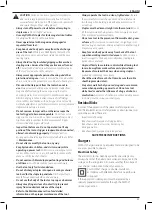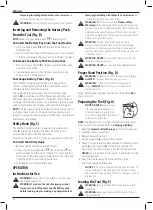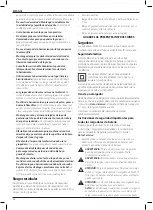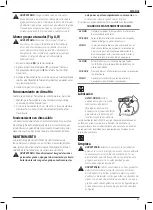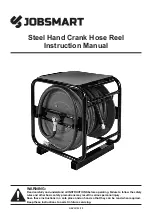
40
EnGLIsh
DAILY MAINTENANCE CHART
ACTION
Clean magazine, pusher, and contact
trip mechanism.
WHY
Permits smooth operation of magazine, reduces
wear, and prevents jams.
HOW
Blowing off the tool with compressed air is the
most effective way to clean the tool. The use
of oils, lubricants periodically or solvents is not
recommended as they tend to attract debris
and/or damage the plastic parts of the tool.
ACTION
Before each use, check to ensure all screws and
staples are tight and undamaged.
WHY
Prevents jams and premature failure of tool parts.
HOW
Tighten loose screws using the appropriate hex
wrench or screwdriver.
Lubrication
NOTICE: NEVER
spray or in
any other way apply lubricants
or cleaning solvents inside the
tool. This can seriously affect
the life and performance of
the tool.
D
e
WALT
tools are properly lubricated at the factory and are
ready for use. However, it is recommended that, once a year,
you take or send the tool to a certified service centre for a
thorough cleaning and inspection.
Cleaning
WARNING:
Blow dirt and dust out of the main housing
with dry air as often as dirt is seen collecting in and around
the air vents. Wear approved eye protection and approved
dust mask when performing this procedure.
WARNING:
Never use solvents or other harsh chemicals
for cleaning the non-metallic parts of the tool. These
chemicals may weaken the materials used in these parts.
Use a cloth dampened only with water and mild soap.
Never let any liquid get inside the tool; never immerse any
part of the tool into a liquid.
Optional Accessories
WARNING:
Since accessories, other than those offered
by
D
e
WALT
, have not been tested with this product, use
of such accessories with this tool could be hazardous.
To reduce the risk of injury, only
D
e
WALT
recommended
accessories should be used with this product.
Consult your dealer for further information on the
appropriate accessories.
Protecting the Environment
Separate collection. Products and batteries marked
with this symbol must not be disposed of with normal
household waste.
Products and batteries contain materials that can
be recovered or recycled reducing the demand for raw
materials. Please recycle electrical products and batteries
according to local provisions. Further information is available at
www.2helpU.com
.
Rechargeable Battery Pack
This long life battery pack must be recharged when it fails
to produce sufficient power on jobs which were easily done
before. At the end of its technical life, discard it with due care for
our environment:
• Run the battery pack down completely, then remove it from
the tool.
• Li-Ion cells are recyclable. Take them to your dealer or a
local recycling station. The collected battery packs will be
recycled or disposed of properly.








